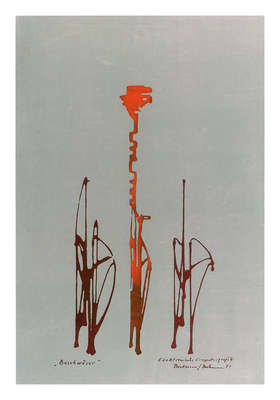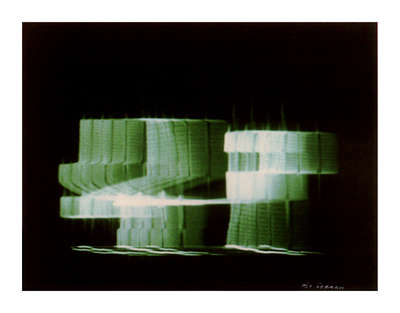Oskar W. Beckann, who is one of the four sons of Otto Beckmann, studied telecommunications at the Technische Hochschule in Vienna. He worked in telecommunications for the aerospace industry as well as an engineer in the R&D division of Siemens. He now lives in St. Pölten, Austria. [cf. Rosen et al., 2011 and Oberquelle and Beckmann, 2008]
His technical interest lead to the construction of a hybrid computer for his father’s artwork. Oskar “was familiar with electronic data processing and Markov generators from his studies (…) and he decided to build a special-purpose computer for his father. He started the development of what became known as the studio computer in 1969.” Oberquelle and Beckmann, 2008, p. 23] The design of the studio computers was based on a cybernetic model of creative work [cf. Nake, 1974] with the artist remaining in the loop. [[cf. Oberquelle and Beckmann, 2008"]] In 1970 Oskar created the so-called a.i.70 (the name stands for ars intermedia and the year 1970), which was followed by improved versions. The studio computer’s development was honored in 1972 with the Austrian “Adolf Schärf Award for the Advancement of Science”. In 1974 and 1977 the machines included the Picture language (PI), which resulted in the development of the final computer a.i.Pl/77. Oskar did further tests for another version of the studio computer, yet cancelling its development in 1978, as his father decided to move his artistic interests into new directions.
“The construction of our art computer was motivated by the desire to realize our theoretical approchaes and the desire for independance, whereby in all our efforts the evaluation of the artistic quality of the results play a decisive role. The technical effort was to therefore carried only so far as appeared necessary to ensure the computer’s usefulness for experimental work on systems-theoretical or artistic projects.” [Rosen et al., 2011, p. 524] Oskar Beckmann describes the construction of an art computer in the paper “Computer Art and the Construction of an Art Computer in Terms of Experimental Computer Science”, which was reprinted in [Rosen et al., 2011, p. 522f]. It was originally published at the Tendencies 5 Symposium – The Rational and Irational in Visual Research Today – Match of Ideas in 1973.
Oskar was a founding member of ars intermedia, with whom he participated in the Tendencies 5.








